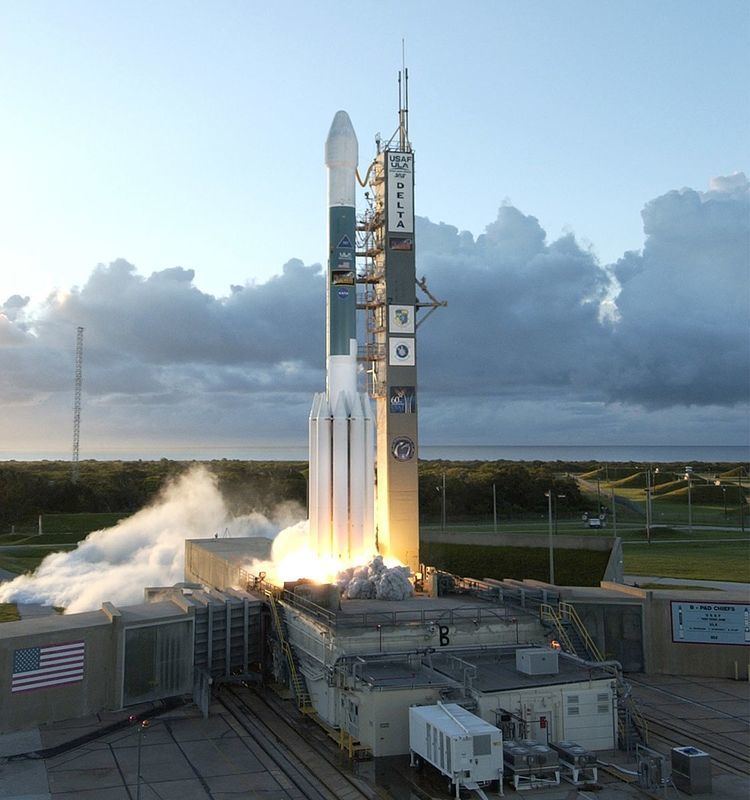 | ||
An expendable launch system is a launch system that uses an expendable launch vehicle (ELV) to carry a payload into space. The vehicles used in expendable launch systems are designed to be used only once (i.e. they are "expended" during a single flight), and their components are not recovered for re-use after launch. The vehicle typically consists of several rocket stages, discarded one by one as the vehicle gains altitude and speed.
Contents
Design rationale
The ELV design differs from that of reusable launch systems, where the vehicle is launched and recovered more than once. Reuse might seem to make systems like the Space Shuttle more cost effective than ELVs, but in practice launches using ELVs have been less expensive than Shuttle launches. (See Space Shuttle Program and Criticism of the Space Shuttle program for discussion of Space Shuttle economics.) Most satellites are currently launched using expendable launchers; they are perceived as having a low risk of mission failure, a short time to launch and a relatively low cost.
History
Many orbital expendable launchers are derivatives of 1950s-era ballistic missiles. As such, cost was not a major consideration in their design. The largest of these is the Titan IV, the second costliest per-flight launch vehicle in history (following the Space Shuttle).
On the other hand, a reusable launcher requires stronger parts and additional parts, thus decreasing payload capacity. The Space Shuttle was a major national asset, used with great and expensive caution. Only five orbiters were built, and the loss of two (Challenger and Columbia) cause great concern and an extended hiatus in Shuttle flights. Expendable launch failures usually caused a much shorter pause, each of which impacted only that model of launcher.
For these reasons the Space Shuttle did not reduce the costs of constructing and launching payloads into orbit and did not replace expendable satellite launchers.
European sponsorship
On March 26, 1980, the European Space Agency and the Centre National d'Etudes Spatiales (CNES) created Arianespace, the world's first commercial space transportation company. Arianespace produces, operates and markets the Ariane launcher family. By 1995 Arianespace lofted its 100th satellite and by 1997 the Ariane rocket had its 100th launch. Arianespace's 23 shareholders represent scientific, technical, financial and political entities from 10 different European countries. The major shareholder is the CNES, with 34.68% of capital.
American deregulation
From the beginning of the Shuttle program until the Challenger disaster in 1986, it was the policy of the United States that NASA be the public-sector provider of U.S. launch capacity to the world market. At the start, NASA subsidized satellite launches, intending to eventually price Shuttle service for the commercial market at long-run marginal cost. On October 30, 1984, United States President Ronald Reagan signed into law the Commercial Space Launch Act. This enabled an American industry of private operators of expendable launch systems. Prior to the signing of this law, all commercial satellite launches in the United States were limited to NASA's Space Shuttle.
On November 5, 1990, United States President George H. W. Bush signed into law the Launch Services Purchase Act. The Act, in a complete reversal of the earlier Space Shuttle monopoly, requires NASA to purchase launch services for its primary payloads from commercial providers whenever such services are required in the course of its activities.
Russian privatization
The Russian government sold part of its stake in RSC Energia to private investors in 1994. Energia together with Khrunichev constituted most of the Russian manned space program. In 1997, the Russian government sold off enough of its share to lose the majority position.
American subsidization
In 1996 the United States government selected Lockheed Martin and Boeing to each develop Evolved Expendable Launch Vehicles (EELV) to compete for launch contracts and provide assured access to space. The government's acquisition strategy relied on the strong commercial viability of both vehicles to lower unit costs. This anticipated market demand did not materialize, but both the Delta IV and Atlas V EELVs remain in active service.
Russian renationalization
Beginning in 2013, the Russian government began a renationalization of the Russian space sector. Among the actions taken was the formation of the United Rocket and Space Corporation (Russian: Объединенная ракетно-космическая корпорация) to consolidate a large number of disparate companies and bureaus. The efforts have continued into 2014. On 19 May 2015 State Duma passed a bill on a creation of Roscosmos State Corporation, further consolidating the industry.
Launch alliances
Since 1995 Khrunichev's Proton rocket is marketed through International Launch Services while the Soyuz rocket is marketed via Starsem. Energia builds the Soyuz rocket and owns part of the Sea Launch project which flies the Ukrainian Zenit rocket.
In 2003 Arianespace joined with Boeing Launch Services and Mitsubishi Heavy Industries to create the Launch Services Alliance. In 2005, continued weak commercial demand for EELV launches drove Lockheed Martin and Boeing to propose a joint venture called the United Launch Alliance to lower costs for the United States government.
